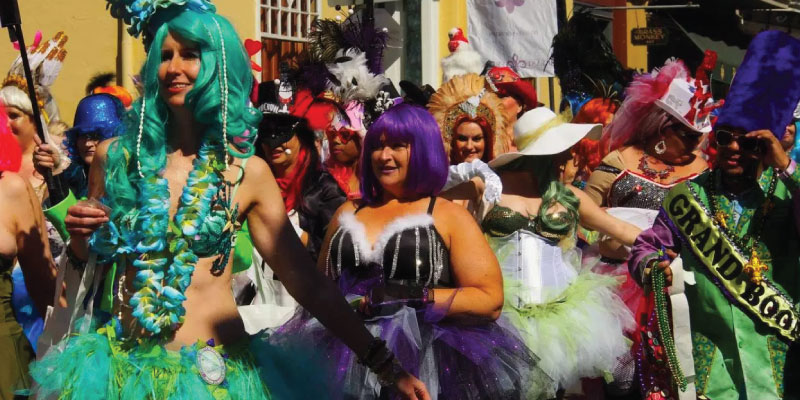By Amy Conner
By their nature, intense romantic relationships are often as complicated as a rocket-operations manual written in Finnish by a Nobel theorist. And, if that relationship belongs to you, it’s a very good idea to ask yourself some questions before you launch that mission to Mars.
For example, are you really experiencing the love of a lifetime or could it simply be an emotional brain-storm resulting from an obscure head-trauma? And don’t forget sex either. Have rampant hormones shanghaied better judgment, enslaved it, and doomed it to breaking rocks while lust is off on a toot, maxing out the credit cards and buying drinks for whores in bars?
Romantic entanglement of any kind has its joys, conundrums, and perils, but the committed relationship is the next best thing to joining one of the lesser messianic cults. Unswerving devotion to a soulmate is remarkably akin to religiosity. Sometimes a kind of soaring ecstasy, at others a martyrdom; commitment and faith are intrinsic to devotion and make no mistake, faith and commitment require a tremendous amount of work that often isn’t pleasant or even productive. The conscious labor of it—hour upon hour, day upon day, all the while knowing the years are passing and the relationship isn’t getting any easier—has the potential to turn you into a raving psychotic who talks to invisible friends.
Perhaps we term these relationships “committed” because there are days when we wish someone would please petition a judge to pack us off to the nut house for a nice rest from love.
For those of us who write in and/or about New Orleans, our connection to this decidedly female town can be compared to being in one of those relationships. Concerned friends and family living elsewhere shake their heads and try to persuade us to give her up; they despair of our ever leaving her and finding someone who, like dietary fiber, will actually be good for us and keep us from getting cancer. We New Orleans writers, though, are the literary equivalent of three-pack-a-day smokers. Oh, there are some who experience epiphanies. It’s rare, but a few come to the midnight realization they have to get out before it’s too late, stuff what they can in garbage bags and leave on the next bus. Those of us who choose to commit, however, ought to question whether our relationship to New Orleans is worth what it costs in terms of practical poverty and the casual way she plays with our hearts. It would be a prudent move to take a long, hard look at this other half of our souls before robbing a bank to buy her that wedding ring.
Common wisdom says to know your enemy, but if you’re a New Orleans writer, knowing your love is vastly more crucial to your survival.
Writers love their Muse even when she abandons them, and New Orleans is a consummate Muse. She can fix you a much-needed drink and your bad paragraph at the same time with equal dexterity. She can flip your tired idea in the air to reveal its insanely lovely obverse for the town has ever delighted in the odd take; the dawn-light in the elusive “what if?” Muses, though, are sloppy creatures rarely rising before noon. They strew underwear in embarrassing places and never put the cap on the toothpaste. They don’t care what they flush and consequently blow up your plumbing. Our Muse, New Orleans, has never held down a straight day job in her life and just because you love her with all your heart, she’s not going to change.
And unlike other towns, she’s not particularly good at being a mother to you either. It’s not as if New Orleans will ever give a damn what time you rolled in last night or if you’re taking your meds. But there’s always something in her house to eat that’s delicious and calling your name from its simmer on the back of the stove. Like Monday’s red beans and rice, even her most prosaic meal is rich with character, dialogue, scene, rhythm, music and time. When you sit down to eat at New Orleans’ kitchen table, the bottle of love is right there next to the Crystal hot sauce. Go ahead, baby, use as much of that as you can stand: over the years of dining with her, New Orleans has altered our palates to the point where the writing flat doesn’t taste right without it.
And should you take her as a lover, it’s important to know for some folks the city’s like a wicked-hot girlfriend—sexy, exciting, fun and laid-back, all at once—but she’ll also blow your rent money for you on cocaine, cheap scotch and a wild night on Frenchmen Street. New Orleans is a great gal for a hurricane party or a So-Someone-Stole-My Car-I-Don’t-Give-A-Damn weekend, but no one to bring home to meet the folks. As Miz Jackie, my favorite check-out lady, says, “It could end up bad, dawlin.” The consequences of hanging with this chick all night and then having to stagger home in pitiless daylight and face the waiting page can be deadly.
And yet we New Orleans writers are committed to her despite the relationship’s inherent difficulties—the endless, hellish summers, roundly decried politics, dirt, crime, third-world streets, rotting houses, and the blithe, insouciant resistance she’s always mounted to being like the rest of America, a country so profoundly different from New Orleans it might as well be Belgium. We work at our relationship with this town harder than seems reasonable because we’ve learned only she has the sustenance in abundance we must have if we’re to spin those stories un-writeable in the rest of the world. Here you learn to leave the back door on the latch so the dream-of-the-day can drop in with its gift of another five precious pages.
Hell, let’s tell the truth: New Orleans waits in a dark doorway to sell us the stuff that lets us breathe—the seriously good stuff—costing only a little more than what you’d otherwise spend on a visit to the shrink.
No matter who she really is, though, how can we not love her? Even writers who can’t, or won’t, live here will lose part of their heart to this irrational, unlikely, and heart-stoppingly compelling portion of ground. In my novel, The Right Thing, Annie Banks, discontented Jackson socialite, anorexic troubled soul and not even a writer, isn’t immune.

We crossed the state line an hour ago, trading the gentle hills of Mississippi for the flatlands of southeastern Louisiana. The miles fly by now. At a quarter to nine, we’re crossing over the Bonnet Carré Spillway with ten miles to go before we hit the city limits.
New Orleans appears to the southeast as a golden arc on the black horizon, its skyline floating above banked clouds of fog and light, and in spite of my nagging suspicion this trip is going to turn out to be a really bad idea, my spirits lift at the sight of the city.
I’ve always loved this town. I love its improbable, tattered buoyancy, its insatiable appetite for all good things and even more bad ones. Ever since I was a child, I’ve loved wandering the shadowed, mysterious streets of the French Quarter, loved sitting by the Mississippi River watching the great ships of the world cleave those terrible, fathomless currents. The challenging grace-note of a solitary jazz-trumpet flung, dare-like, against the evening sky; a long, cold drink in a short, dark bar while on its hidden courtyard rain courses silver tears on the face of a marble dryad—Oh, Lord, if I was ever going to let my life run away with me for real, I’d hope to elope with New Orleans. It’d be a sight more effective than hiding underneath the duvet and a whole lot more fun.
It’s an aspect of this committed relationship requiring patience and social skills: there will always be people who naively fall for our town, and it’s up to us, the writers, to attempt soothing their dismay when the love of our life gets so trashed she throws up on their baby. We earn the privilege of living here, but New Orleans lives within us, too, and so we also have the responsibility to care for her, always, in our life’s work. We must tell her truths as well as her lies. Love isn’t blind, but we must love her as uncritically and generously as we can, for that’s the way she loves us, too. Even when we write of other places, a secret part of every story will be just for her. Somehow, it will echo her belly-laugh, her second-line hymn, her scream of grief.
Her rapture at the unassailable fact that, against all the odds, we are still here.
I once wrote a short essay for a vanity publication of New Orleans stories and it’s (mostly) true. While reading it at some enormous, faceless civic center in Jefferson Parish I hadn’t known existed before that night, I looked up from the page at the assembled group of contributing writers and realized everyone in the room was in the same screwy relationship with New Orleans I’d been in since I was seven. Almost to a person, we’d been through it all with New Orleans. Great times and terrible, the dancing and the mourning; the pointless, circular arguments and the shattering moments of inchoate, transcendent and mutual recognition—everyone in that room had made the decision—conscious or not—we were in this for life, the longest haul of them all.
New Orleans writers can’t help it. We have the deep, wordless understanding there’s no other place for us where we’re our authentic selves, come gangsters and guns, thieving lawyers and idiot bureaucrats, millennial floods or the freaking Gulf of Mexico.
That night’s essay, I Love This Town, commemorates the occasion I finally got it: this committed relationship was no longer in question and hadn’t been since the day we met.
I had a rat problem.
No matter how many times I called Orkin, they always said they couldn’t help me. The Norway rats infesting my miniscule New Orleans back yard actually lived in the semi-abandoned house behind my fence, consuming a debris-field of gnawed Popeye’s’ chicken bones, greasy bags and styrofoam containers of moldy mashed potatoes and red beans. These represented leftovers from the impromptu picnics and al fresco get-togethers the neighborhood drug lord and his gang would sometimes hold there before decamping to go a-dealing. It was up to me, the homeowner next door, to venture inside that ramshackle house and hoe out the gang’s mess if I didn’t want a nonstop rat-party going on in my backyard.
As a squeamish, white Uptown woman, naturally that wasn’t high on my To-Do List.
Instead I got a dog who immediately proved to have no interest in rats whatsoever. Steve was only committed to going AWOL from the backyard and rambling around town on mysterious missions of his own. Maybe he was as revolted by the rodent infestation as I was; maybe he was looking for less degrading and more profitable employment. At any rate, while the rats lolled on the grass in smoking jackets playing hands of bridge and drinking Mai-Tais, Steve was elsewhere. He was a failure as an exterminator, true, but I worried a lot when he went missing since in every other regard Steve was a pretty good dog. For months I’d go hunting him and on rare occasions he’d be found. More often, though, it would be days before the dog made his way back to the house.
So when I’d come home from work to learn I was once again Steve-less, I began heading out into my crumbling, sort-of dangerous neighborhood armed with a staple gun and an armful of lost-dog flyers. I’d use the popular telephone poles armored in a spiky skin of previous staples to notify the world of my intention to reward anyone who could effect Steve’s return.
And it didn’t take long before local urchins began showing up at my door with news. The dog had been spotted on St. Charles Avenue chasing a streetcar full of off-duty cops. He was under a house by the Cohn Street cemetery having relations with a lady dog of indeterminate origins. Steve was in the Langenstein’s parking lot, panhandling scandalized Uptown society doyennes for spare change. For the paltry sum of twenty dollars, the urchins offered to collect the dog and escort him right to my front door, and I was grateful—until it finally dawned on me this was a ransom operation. I paid up anyway, though, because then Steve would come home.
In this way the rats partied on for months and I kept paying until the day when living with being extorted became unendurable. Steve was gone again, but instead of forking over the usual twenty bucks, I grabbed the ransomer’s Teenage Mutant Ninja Turtle sweatshirt and yanked him into my determined orbit. He guiltily blinked like one of those roadside church signs advising hellfire for offending Jesus as I grated, “Okay, kid, where the hell is my dog?”
Two minutes later I was banging on the door of a shady-looking house only a block from mine. No one answered, and so fueled by outrage and that suicidal urban fury of the “enough is enough” persuasion, righteously I stormed into the front room where the neighborhood gang was cutting up a black garbage bag full of fragrant weed. With a thunderous round of clicks, every last gangster cocked and leveled a handgun at me while Steve, that miscreant, was fawning at the feet of the gang’s head dude. Lounging in a green vinyl recliner, he was in the act of giving Steve a crispy wing from a giant-sized box of Popeye’s.
“This your dog?” The dealer lowered his Glock and looked disgusted. “He hangin by here all the time, ate three wings today already. Don’t you never feed his ass?”
After that exchange the ransom operation ended, but I built a taller fence anyway and Steve quit roaming. Too, in the spirit of supporting the local economy and encouraging responsible, youthful enterprise, I paid the neighborhood kids a bounty of five dollars apiece for rat carcasses. In time the rodent party relocated to a less disruptive venue and the drug lord (whose name is Jesse) now always stops to talk whenever we meet on the street.
Jesse says, “How you doin, neighbor? Still feedin that dog, right?” He seems genuinely concerned for Steve’s welfare.
I love this town. I tell myself that every day. I love this town, and, no matter what, we’ll work it out together somehow.
And I’ll write about it because that’s what writers in committed relationships do.

AMY CONNER is a sixty-ish, life-long New Orleanian currently living on her daughter’s couch with her two dogs, Baggage and Weasel, since her own house is “staged” and she’s not allowed to live in it. Ms. Conner is also the author of two books published by Kensington Press, The Right Thing and Million Dollar Road, as well as two other as-yet-unpublished novels. Over the years, Ms. Conner has held many, many jobs including runway model, private investigator, oriental rug salesperson, horse trainer, co-owner and manager of the world’s largest alligator farming concern, wife (now divorced) and mother of two wonderful kids (forever.)
Should anyone be at all interested in buying Ms. Conner’s 300-year-old house in the Treme neighborhood of New Orleans, please contact her real estate agent asap and thank you.
Check out her website.

